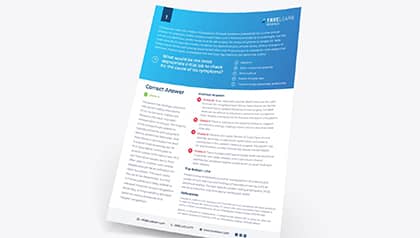PANCE Study Guide: Step-by-Step Strategies for Exam Success
A structured study guide for the Physician Assistant National Certifying Examination (PANCE) makes all the difference. Administered by the National Commission on the Certification of Physician Assistants (NCCPA), the PANCE is one of the final hurdles to becoming a certified physician assistant (PA). It assesses your clinical knowledge, reasoning, and other medical skills to determine if you’re capable of performing your PA duties efficiently and safely.
Passing on your first attempt may seem like a challenge, but our PANCE study guide provides a structured approach, effective strategies, and essential tools to help you succeed. Let’s dive in!
Understanding the PANCE Exam Blueprint
Did you know that 94% of the PANCE is compromised by medical content? The PANCE blueprint outlines the percentage allocation in each medical category as follows:
- Cardiovascular: 11%
- Pulmonary: 9%
- Gastrointestinal/Nutrition: 8%
- Musculoskeletal: 8%
- Infectious Diseases: 7%
- Neurologic: 7%
- Psychiatry/Behavioral Science: 7%
- Reproductive: 7%
- Endocrine: 6%
- Eyes, Ears, Nose, and Throat: 6%
- Professional Practice: 6%
- Hematologic System: 5%
- Renal: 5%
- Dermatologic: 4%
- Genitourinary System: 4%
You’ll also be tested in task categories, ranging from diagnostic and lab studies to clinical interventions. Each medical content question is coded to one of the task areas, so completing practice questions is a must. Use a question bank mapped to the official blueprint for PANCE exam practice!
How to Build Your PANCE Study Timeline
Start six to three months before the exam by taking a baseline practice assessment. An assessment will help you gauge your current understanding and identify content areas that you could further improve upon.
From there, you’ll create a weekly study schedule. Each week should include daily study blocks focused on the content areas of the PANCE exam. Aim for at least three hours of studying each day with frequent, scheduled 15-minute breaks to increase productivity while avoiding burnout.
In the final four to six weeks leading up to the exam, hyper-focus your review on any areas of weakness. Then, a week before your exam, slow down your study routine. This time should only be used for light review, practice questions, and no cramming whatsoever. You know what you know—trust yourself and rest up.
Top Study Strategies for Exam Success
Practice PANCE style with question banks
The best way to familiarize yourself with the exam’s content (other than reading our PANCE overview) is to use a question bank. Question banks help you master answering questions accurately, recall information faster, and understand difficult medical concepts.
TrueLearn’s PANCE Question Bank is mapped to the NCCPA content blueprint and contains more than 800 questions. With custom quizzing and high-quality explanations, you can improve both your retention and performance.
Mix in timed blocks for stamina
Set aside timed study blocks for practice questions throughout your routine. We recommend starting with 15 minutes, then increasing the time until you’re able to answer 60 questions in 60 minutes. A time approach allows you to see where you’re getting stumped, refine your test-taking strategies, and build stamina for exam day.
Use practice tests to simulate pacing
The PANCE is five hours long with 300 multiple-choice questions. There are 5 60-minute blocks, with 15-minute breaks in between each block. To practice your pacing and answer each question, take a practice test and act as if it were exam day. Your pace should match your timed practice question sessions.
Avoiding Common PANCE Study Mistakes
Studying only your favorite topics
A refresher is necessary from time to time. However, your study time should also focus on improving areas of weakness. Set yourself up for success by dedicating review time to all topic areas—not simply your favorites. You’ve mastered those already!
Not practicing under timed conditions
Timing yourself may seem like unnecessary pressure, but it’s crucial to build your stamina for the PANCE. On exam day, you should have the ability to answer questions within the allotted time and avoid missing any questions due to time constraints.
Ignoring the blueprint’s weighted content areas
The blueprint is your true PANCE study guide. Spend more time studying in larger weighted areas, but don’t neglect the smaller ones either! If you’ve perfected a content area, move on to the next.
How to Use TrueLearn to Maximize Your PANCE Prep
TrueLearn’s PANCE SmartBank has more than 800 practice questions mapped to the PANCE blueprint. Our easy-to-navigate online platform is accessible on your desktop or on the go with the mobile app!
You can create your own flashcards for quick review or use custom quizzing to focus on weaker content areas. With everything you need in one place, our performance dashboard allows you to track your progress and see how you measure up to your peers nationwide.
The best part? If you have a 90+ day subscription, we guarantee you’ll pass on your first attempt. Sign up today.
Sample Week: “Final Sprint” PANCE Study Plan
Your study plan won’t look like your colleagues—that’s okay! If you need extra support, refer to this guide to create your schedule for the final weeks leading up to your exam.
- Day 1-2: Cardiovascular and Pulmonology question bank blocks
- Day 3: Gastrointestinal and Surgery with mixed review
- Day 4: Neurology, Psychology, and Pharmacology
- Day 5: Full-length timed practice exam
- Day 6: Review incorrect answers from the exam and refine your notes
- Day 7: Light review and rest
The PANCE is predictable if you follow the blueprint, study with active recall, and test your readiness before exam day.


